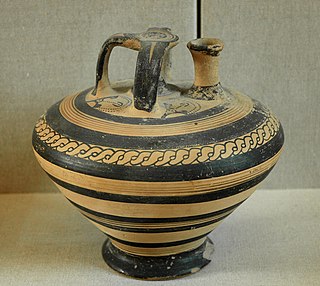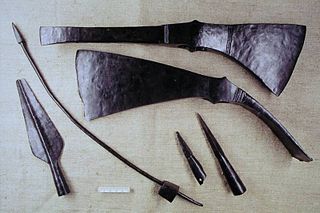Particle-induced X-ray emission or proton-induced X-ray emission (PIXE) is a technique used for determining the elemental composition of a material or a sample. When a material is exposed to an ion beam, atomic interactions occur that give off EM radiation of wavelengths in the x-ray part of the electromagnetic spectrum specific to an element. PIXE is a powerful, yet non-destructive elemental analysis technique now used routinely by geologists, archaeologists, art conservators and others to help answer questions of provenance, dating and authenticity.

An artifact or artefact is a general term for an item made or given shape by humans, such as a tool or a work of art, especially an object of archaeological interest. In archaeology, the word has become a term of particular nuance and is defined as an object recovered by archaeological endeavor, which may be a cultural artifact having cultural interest.
Gold fingerprinting is a method of identifying an item made of gold based on the impurities or trace elements it contains.

The British School at Athens is an institute for advanced research, one of the eight British International Research Institutes supported by the British Academy, that promotes the study of Greece in all its aspects. Under UK law it is a registered educational charity, which translates to a non-profit organisation in American and Greek law. It also is one of the 19 Foreign Archaeological Institutes defined by Hellenic Law No. 3028/2002, "On the Protection of Antiquities and Cultural Heritage in General," passed by the Greek Parliament in 2003. Under that law the 17 accredited foreign institutes may perform systematic excavation in Greece with the permission of the government.
Petrography is a branch of petrology that focuses on detailed descriptions of rocks. Someone who studies petrography is called a petrographer. The mineral content and the textural relationships within the rock are described in detail. The classification of rocks is based on the information acquired during the petrographic analysis. Petrographic descriptions start with the field notes at the outcrop and include macroscopic description of hand-sized specimens. The most important petrographer's tool is the petrographic microscope. The detailed analysis of minerals by optical mineralogy in thin section and the micro-texture and structure are critical to understanding the origin of the rock.
Archaeological science consists of the application of scientific techniques to the analysis of archaeological materials and sites. It is related to methodologies of archaeology. Martinón-Torres and Killick distinguish ‘scientific archaeology’ from ‘archaeological science’. Martinón-Torres and Killick claim that ‘archaeological science’ has promoted the development of high-level theory in archaeology. However, Smith rejects both concepts of archaeological science because neither emphasize falsification or a search for causality.

Fritware, also known as stone-paste, is a type of pottery in which frit is added to clay to reduce its fusion temperature. The mixture may include quartz or other siliceous material. An organic compound such as gum or glue may be added for binding. The resulting mixture can be fired at a lower temperature than clay alone. A glaze is then applied on the surface.
Igneous petrology is the study of igneous rocks—those that are formed from magma. As a branch of geology, igneous petrology is closely related to volcanology, tectonophysics, and petrology in general. The modern study of igneous rocks utilizes a number of techniques, some of them developed in the fields of chemistry, physics, or other earth sciences. Petrography, crystallography, and isotopic studies are common methods used in igneous petrology.

Forensic materials engineering, a branch of forensic engineering, focuses on the material evidence from crime or accident scenes, seeking defects in those materials which might explain why an accident occurred, or the source of a specific material to identify a criminal. Many analytical methods used for material identification may be used in investigations, the exact set being determined by the nature of the material in question, be it metal, glass, ceramic, polymer or composite. An important aspect is the analysis of trace evidence such as skid marks on exposed surfaces, where contact between dissimilar materials leaves material traces of one left on the other. Provided the traces can be analysed successfully, then an accident or crime can often be reconstructed. Another aim will be to determine the cause of a broken component using the technique of fractography.
QEMSCAN is the name for an integrated automated mineralogy and petrography system providing quantitative analysis of minerals, rocks and man-made materials. QEMSCAN is an abbreviation standing for quantitative evaluation of minerals by scanning electron microscopy, and a registered trademark owned by FEI Company since 2009. Prior to 2009, QEMSCAN was sold by LEO, a company jointly owned by Leica and ZEISS. The integrated system comprises a scanning electron microscope (SEM) with a large specimen chamber, up to four light-element energy-dispersive X-ray spectroscopy (EDS) detectors, and proprietary software controlling automated data acquisition. The offline software package iDiscover provides data processing and reporting functionality.
Alan George Vince was a British archaeologist who studied Saxon, medieval and early modern ceramics through the application of petrological, geological and archaeological techniques. He was also a teacher and a pioneer in the use of computers and the internet in archaeology.

Archaeometallurgical slag is slag discovered and studied in the context of archaeology. Slag, the byproduct of iron-working processes such as smelting or smithing, is left at the iron-working site rather than being moved away with the product. As it weathers well, it is readily available for study. The size, shape, chemical composition and microstructure of slag are determined by features of the iron-working processes used at the time of its formation.

Rehydroxylation [RHX] dating is a developing method for dating fired-clay ceramics. This new concept relies on a key property of ceramic materials, in which they expand and gain mass over time. After a ceramic specimen is removed from the kiln at the time of production, it immediately begins to recombine chemically with moisture from the environment. This reaction reincorporates hydroxyl (OH) groups into the ceramic material, and is described as rehydroxylation (RHX). The phenomenon has been well-documented over the past one hundred years, and has now been proposed as a means to date fired-clay ceramics. The RHX process produces an increase in specimen weight and this weight increase provides an accurate measure of the extent of rehydroxylation. The dating clock is provided by the experimental finding that the RHX reaction follows a precise kinetic law: the weight gain increases as the fourth root of the time which has elapsed since firing. This power law and the RHX method which follows from it were discovered by scientists from the University of Manchester and the University of Edinburgh.

Nahal Hemar Cave is an archeological cave site in Israel, on a cliff in the Judean Desert near the Dead Sea and just northwest of Mount Sodom.

Cypriot Bichrome ware is a type of Late Bronze Age, and Iron Age, pottery that is found widely on Cyprus and in the Eastern Mediterranean. This type of pottery is found in many sites on Cyprus, in the Levant, and also in Egypt. It was typically produced on a pottery wheel. A large variety of decorations and motifs are attested. This pottery is very similar to certain types of the Mycenaean pottery from various locations.
This page is a glossary of archaeology, the study of the human past from material remains.
The conservation and restoration of ancient Greek pottery is a sub-section of the broader topic of conservation and restoration of ceramic objects. Ancient Greek pottery is one of the most commonly found types of artifacts from the ancient Greek world. The information learned from vase paintings forms the foundation of modern knowledge of ancient Greek art and culture. Most ancient Greek pottery is terracotta, a type of earthenware ceramic, dating from the 11th century BCE through the 1st century CE. The objects are usually excavated from archaeological sites in broken pieces, or shards, and then reassembled. Some have been discovered intact in tombs. Professional conservator-restorers, often in collaboration with curators and conservation scientists, undertake the conservation-restoration of ancient Greek pottery.
James B. Stoltman was an American archaeologist who specialized in the American Midwest.

SEM-XRF is an established technical term for adding a X-ray generator to a Scanning Electron Microscope (SEM). Technological progress in the fields of small-spot low-power X-ray tubes and of polycapillary X-ray optics has enabled the development of compact micro-focus X-ray sources that can be attached to a SEM equipped for energy-dispersive X-ray spectroscopy.

David Philip Spencer Peacock was a British archaeologist. Educated at Stamford School and at the University of St Andrews, he spent most of his career at the University of Southampton, where he specialised in the scientific study of Roman pottery.











